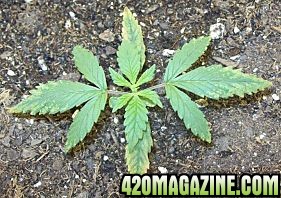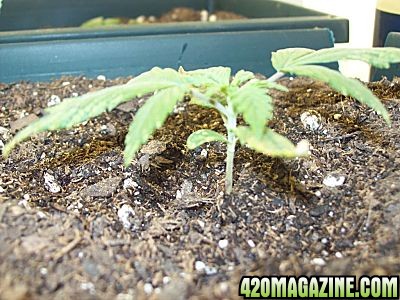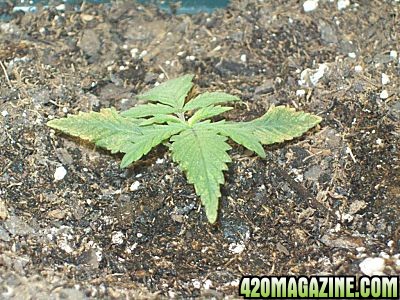- Thread starter
- #121
grandpastoner
New Member
Re: Grandpa's White Widow - 2nd Grow...NO MISTAKES!
An extremely enlightening answer. I am very delighted that you took so much time and put so much effort into giving me an such an answer. It's been a while since gramps was in a chem class...and that last one took place at a party in NorCal, and I don't really remember much of it. But seriously dude Thanxxx so much ! It is all a huge help man.


By the way...I just went and checked on my ladies and I swear I see a decent amount of growth since last night. Maybe this shit I put together really works !
Maybe this shit I put together really works !
I have one more question...I am putting the perlite and FF together tonight an transplanting the ladies. Should I completely water the soil prior to putting the jiffy cups into it ? Or put them into the soil first, and then water the hell out of it ?
Thanxxx again l8tnightskunk ! Rep to you dude.
pH is the measure of how basic or acidic a solution is. The pH of a substance is measured in a numerical fashion using a scale of 1 through 14. A solution with a pH higher than 7.0 is considered to be basic and is called a base (or alkaline). A solution with a pH less than 7.0 is considered to be acidic and is called an acid. The strength of an acid or base can be either weak or strong. The stronger an acid or base, the closer the solution is to its respective number on the pH scale (basic being 15 and acid being 1). The weaker a solution or base, the closer its pH value is to a neutral rating (neutral being 7). Every full point change in pH signifies a 10 fold increase or decrease in acidity or alkalinity. For example, water with a pH of 6.0 is 10 times more acidic than water with a pH of 7.0, while water with a pH of 5.0 is 100 times more acidic than water with a pH of 7.0.
Here are some examples of acids and bases and their respective pH ratings.
-.2 Battery Acid
1.2 Gastric fluid
2.2 Lemon juice
3.6 Orange juice
4.4 Beer
5.6 Pure Rain
6.6 Milk
7.0 Distilled water (H2O)
8.0 Seawater
9.2 Baking soda (NaHCO3)
10.6 Milk of Magnesia (Mg(OH)2)
11.4 Household ammonia (NH3)
12.8 Household bleach (NaClO)
13.6 Household lye (NaOH)
pH is defined in chemistry in several ways. An acid is sometimes defined as a solution with the potential to donate a Hydrogen ion (H+, also called a proton), or to accept a Hydroxide Ion (OH-) from a base. A base on the other hand is sometimes defined as a solution with ability to donate a Hydroxide Ion, or... you've guessed it, accept a Hydrogen ion. Low pH corresponds to a high hydrogen ion concentration and vice versa, while a high pH corresponds to a high Hydroxide ion concentration and vice versa.
Why is pH important when growing a plant?
Any substance that is going to be used to support any form of life has to fall within a certain range on the pH scale. The range may vary from organism to organism. marijuana is no different. The soil, nutrient solutions and water all need to be monitored and adjusted to stay within a specific range, depending on your method of growing. When growing marijuana in soil, the soil and water supply should stay within the range of 6.5 to 7.0, while in hydroponics the nutrient solution should stay within the range of 5.5 and 6.0.
When a plant's soil or nutrient solution becomes too basic the nutrients become unavailable to be absorbed by the roots. When the soil or nutrient solution becomes too acidic the acid salts will chemically bind together the available nutrients and they will be nonabsorbent by the roots. When this happens the plant will show tell-tale signs of stress. Some novice growers and even a few seasoned growers will falsely think they need to add more nutes or fert, which only compounds the problem by usually causing toxic salt build-up. Toxic salt build-up stops the roots from absorbing water. So remember as a rule of thumb to always test the pH before reducing or increasing a fert or nute dosage!
The pH of your soil or hydroponics setup can be measured with a simple 20$ or 30$ pH Tester, or small one time paper tests. These are highly recommended when growing any plant.
Some things to remember when using an electronic pH tester
1. Clean the probes of the meter after each test and wipe away any corrosion.
2. Pack the soil tightly around the probes.
3. Water soil with distilled or neutral pH water (7.0) before testing.
4. The meters measure the electrical current between two probes and are
designed to work in moist soil. If the soil is dry, the probes do not give
an accurate reading
What causes fluctuations in pH?
When growing in soil any fertilizer you use can cause an excess build up of salts when it decomposes in the soil. This almost always results in a more acidic soil which stunts the plant's growth and causes brown foliage. When using a Hydroponics set-up the nutrient solution can very easily cause a fluctuation in the growing reservoir. Other common reasons as to why soil may become too acidic when doing outdoor grows are rainfall, leaching, organic matter decay and a previous harvest of a high yeild crop in the same soil. In dry climates, such as the desert Southwest US, Spain, Australia, etc., irrigation water is often alkaline with a pH above 7. The water in rainy climates, such as the Pacific Northwest of North America, the UK, Netherlands and Northern Europe, is often acidic with a pH below 6. Lightly sandy soils with little clay and organic matter are quicker too become more acidic. Another common mistake is that a grower will mix his soil unevenly, leading to "hot spots" in the growing medium, so mix all ratios as well as you can.
How do I raise/lower my pH?
A great way to regulate the pH of your soil is to use Dolomite Lime(calcium-magnesium carbonate). While growing Cannabis plants in containers, mix one cup of fine dolomite lime for each cubic foot of soil, then lightly water it. After watering, mix it once more and wait a day or two before checking the pH. While growing in an outdoor garden, follow the dolomite lime manufacturers instructions. Dolomite Lime works well because it has a neutral pH rating of 7.0 and tends to keep the soil a constant pH throughout the entire life cycle of the plant. This is a highly recommended method of regulating your soil pH.
If you find the pH of your soil or Hydroponic reservoir to be too acidic or basic you could add either pH up or pH down. These are chemicals sold at places like Home Depot or any Gardening store. They usually come in one liter bottles and are to be diluted in the water used to water the soil growing plants or the Hydroponic reservoir according to directions on the packaging.
Some examples of Home remedies to raise/lower pH are as follows:
1.Lemon juice. 1/4 tbsp can bring a gallon of tap-water from 7.4 to 6.3.
2.Phosphoric acid. lowers pH and provides Phosphor too!
3.Nitric acid. lowers pH.
4.Hydrochloric acid. strongest way to lower pH
5.Hydrated lime. flush soil with a teaspoon per gallon of water to raise pH.
6.Baking Soda. eats acids to raise pH.
7.Calcium carbonate. raises pH (very strong)
8.Potassium silicate. raises pH.
What are signs of a PH fluctuation in my Cannabis plant?
A Cannabis plant can show signs of a pH flux in several ways. The leaves may begin to turn yellow or brown, dry up and/or shrivel on the sides into a straw like shape. Keep in mind however that other deficiencies and disorders may show the same signs of damage, so don't jump to conclusions until you do some testing and adjusting to your plants and their growing medium.
Some things to remember
1.Always test the pH of raw water and drainage water with a pH meter.
2.Raw water pH above 6.0 helps keep fertilizer mixes from becoming too acidic.
3.The pH level is much more important in organic soil gardens than in chemical
hydroponic gardens. The pH dictates the environment of bacteria necessary to the
uptake of organic nutrients.
An extremely enlightening answer. I am very delighted that you took so much time and put so much effort into giving me an such an answer. It's been a while since gramps was in a chem class...and that last one took place at a party in NorCal, and I don't really remember much of it. But seriously dude Thanxxx so much ! It is all a huge help man.



By the way...I just went and checked on my ladies and I swear I see a decent amount of growth since last night.
 Maybe this shit I put together really works !
Maybe this shit I put together really works ! I have one more question...I am putting the perlite and FF together tonight an transplanting the ladies. Should I completely water the soil prior to putting the jiffy cups into it ? Or put them into the soil first, and then water the hell out of it ?

Thanxxx again l8tnightskunk ! Rep to you dude.




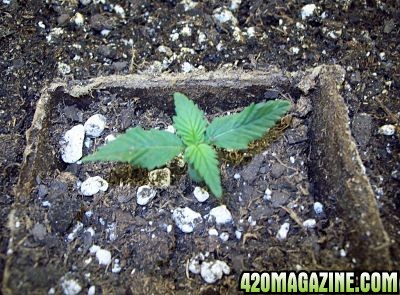
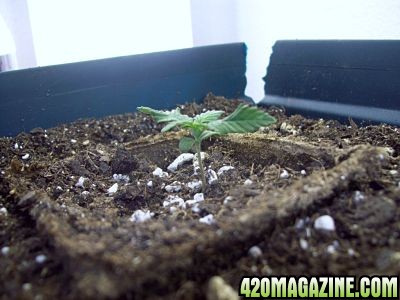
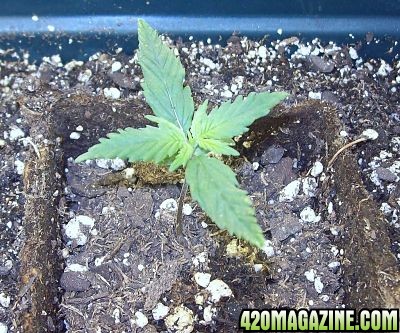
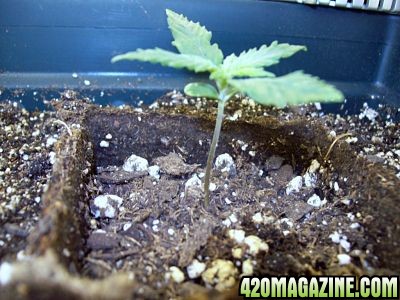

 The co2 seems to be making a difference.
The co2 seems to be making a difference. 
 But it's cool. I'm not sleeping in the basement. So only the ladies have to breathe it. And they seem to love it !
But it's cool. I'm not sleeping in the basement. So only the ladies have to breathe it. And they seem to love it ! 